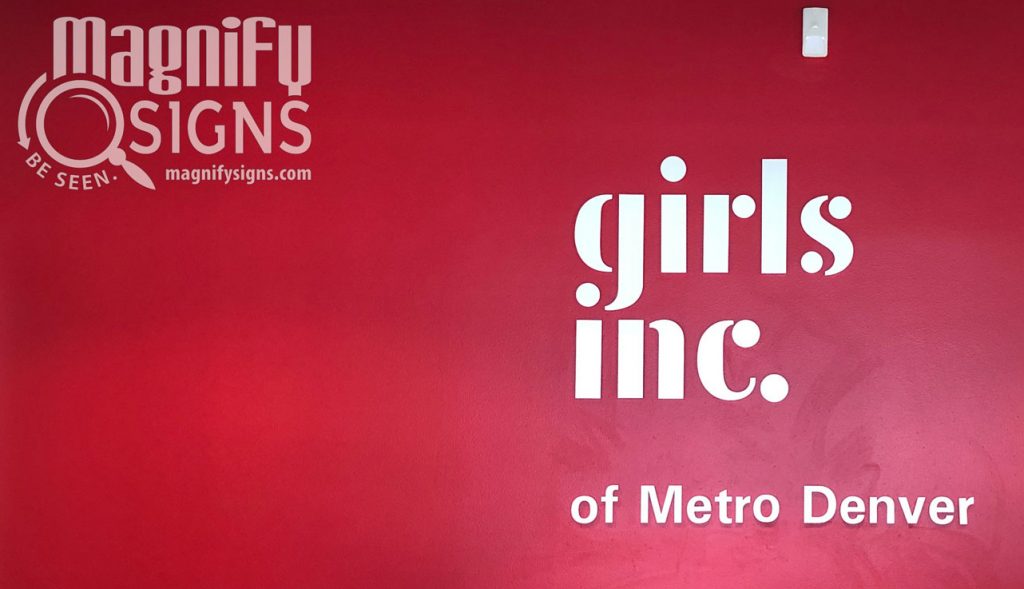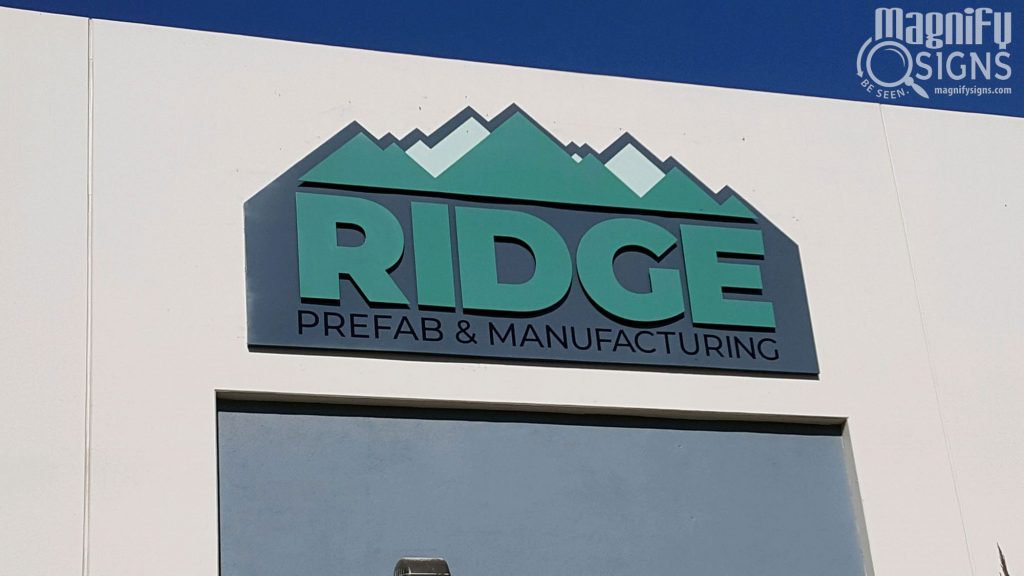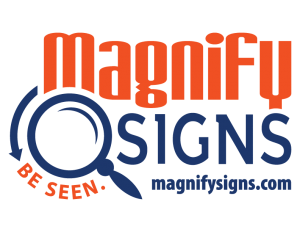Your business sign is the first thing that potential customers and clients see. You really want to impress them but you also want your business sign to represent your business, your line of work, and your professionalism. There are a lot of choices to make when designing a business sign: material, size, type, colors, placement of your logo, and fonts for your text. All this will determine how people see your business’s signage—or even if they see it at all!
So, what are the best fonts for a business sign and what should you consider while designing your business signage?
Design Elements
There are thousands of different fonts out there, but all of them fall under a few main categories:
- Serif and Slab Serif Fonts: These are fonts with so-called projections (little “hands” or “feet”) coming off the ends of the letters. These could be small, barely noticeable projections or large extravagant ones. As an example, Times New Roman is a Serif font.
- Sans-Serif Fonts: This literally means “without serifs.” Arial and Helvetica are sans-serif fonts because they lack the projections off the ends of the letters.
- Script Fonts: These fonts are extravagant and flowing, often taking a cursive form. They take on more of a calligraphy-related or handwritten style. They could be elegant, lighthearted, or something in between.
- Decorative fonts: These may take on a geometric style, a stencil style, or something else entirely. They may have exaggerated serifs or bulbous weights. They are pretty much almost anything else that doesn’t fall into the above categories.
Other elements also impact how a font appears.
- Spacing: Some fonts are condensed (the letters are close together) and some are more spaced out. The space above and below the letters also plays into this element.
- Thickness: Is the font heavily bolded or very thin? Is it something in between?
- Embellishments: Things like exaggerated serifs or swirling embellishments can be pretty. However, when it comes to signage, less is better because they can get hard to read.
Indoor Or Outdoor Business Signage?
The first thing to decide is whether your sign will be indoors or outdoors. This matters because outdoor signs are meant to be seen fast. People are either driving or passing by. They only have a few seconds to read your sign.
Indoor signs are intended for slower reading.
They can afford to be more elaborate since people have already entered your business and have time to read your sign. This relative liberty does not imply that your indoor business sign should be brimming with script fonts, titles, letters, colors, and logos. Signs are designed to catch people’s attention and to be read, so readability is of utmost importance. A sign that includes too much information—verbal or illustrated—will just be ignored.
Outdoor signs need to grab your attention within a split second.
They need clear fonts with enough spacing between the characters (letters) to maximize visibility and readability. Also, outdoor signs are best read with enough “breathing” space around the text. Texts that are squeezed around the edges of a sign are hard to read.
The Big Question: Serif Or Sans-Serif?
 Of all the choices you must make about your font, the most basic is serif or sans-serif. People sometimes find it hard to decide whether they want their sign to be in serif or sans-serif.
Of all the choices you must make about your font, the most basic is serif or sans-serif. People sometimes find it hard to decide whether they want their sign to be in serif or sans-serif.
Serif fonts like Times New Roman are perceived as more refined and stately. They are also easy on the eye in large texts. Sometimes, however, they are seen as old fashioned and conservative.
On the other hand, sans-serif fonts like Helvetica and Arial are associated with modernity, durability, strength, and robustness.
The general consensus is that businesses use sans-serif fonts in titles and serif in longer texts. Sans-serif fonts work best for statements on your signs and short, sharp sentences with few words.
What Image Is Your Business Trying To Promote?
The most important rule concerning fonts is that they should reflect your business.
If you are selling children’s books or toys, a sans-serif font could be perceived as too dry and boring. A childish, playful font reminding customers of a child’s writing, would be more appropriate.
Similarly, a bank trying to reinforce an image of strength, accountability, and security would miss the point if it adopted a sign with childish fonts. In this case, serif fonts promote the image of a bank with a strong and stately background; the kind of bank to keep your money safe.
Each font has its own image and a whole “story” associated with it. It’s good to remember what your business stands for and what sort of clientele it aims to attract when choosing the right font for your business signage.
Examples Of Font Style And Branding
 Here are some more examples of how the right fonts can amplify your company’s brand.
Here are some more examples of how the right fonts can amplify your company’s brand.
- Professional Fonts: Law firms, doctors, and other more professional businesses may want to use serif fonts like Copperplate or Palatino. These may offer a clean, professional, and reliable look to your sign design.
- Gender Fonts: Stereotypical gender fonts could really help amplify your brand. Often, more delicate or script-like fonts are best used for feminine brands while bold fonts are best for masculine brands.
- Children’s Fonts: Fonts such as Khaki or Ravie look artsy and childish, but are still easy to read. They could be perfect for a toy store.
- Classic or Conservative Fonts: These are refined much like professional fonts are, but more subdued and not as bold. Times New Roman, Roman Serif, or Goudy Handtooled are wonderful for this style.
- Whimsical and Artsy Fonts: Fonts that match a time period (like Eurostile or Bauhaus) offer a more retro appearance, whereas a font like Biffo allows for a more careless and fun look.
What Attracts More Customers: Lowercase Or Uppercase?
 The human eye reads better and faster lowercase characters.
The human eye reads better and faster lowercase characters.
Therefore, a text with lowercase letters is more intuitively understood by the human brain.
Similarly, uppercase letters are usually associated with urgency, attention, and danger.
Uppercase letters are useful for titles, statements, and displays of authority. If you have some specialty in your area, it’s good to advertise it on your business sign with uppercase. However, in the modern digital era, uppercase is also correlated with someone shouting. So, keep this in mind when designing your business sign.
Too Many Fonts: Not A Case Of “The more, The Merrier”
A business sign that has too many fonts will confuse people.
People will not understand what your business represents and they may even wonder whether you are a font designing business promoting your font designs.
It is generally advised to use up to two different fonts in a business sign, preferably contrasting ones so that they each catch customers’ attention.
Using two similar fonts could lead people to wonder whether there was a mistake in the design and production of the business sign. Contrasting fonts could be used for the title and the text, or between the title and your business slogan.
Smart Ways To Use Your Motto In Your Business Sign
Don’t assume that your business sign should have your business name first.
Perhaps your business is already celebrated thanks to a particular catchphrase or slogan. Think about using these in your business sign to attract people’s attention so that they immediately understand who you are.
For example, if you are into insurance and your motto is, “Better late than never,” you could include this slogan in a prominent place in your business sign.
How To Use Script Fonts In Your Business Signage
Script fonts are interesting and quirky. However, they are hard to read in business signs, especially when someone is driving past.
Script fonts are similar to handwriting and give a sense of personal touch, intimacy, and elegance. All these characteristics can be wonderful. However, script fonts on business signs can be tricky.
Script fonts can be difficult to decipher. Also, the relatively limited space in a business sign means that script fonts are sometimes squeezed, which makes their readability even worse. Unless you are selling a romantic novel or dresses from the 19th century, script fonts can be hard to combine in your business sign.
If you feel your business line of work is well served by a script font, then put in the title of your sign and use only lowercase: script font in uppercase makes it almost impossible to read.
Be Consistent Across All Marketing And Business Literature
 Your business sign is only one component of your business. You will probably also have business cards, a business website, business brochures, promotional leaflets, and other business-related literature.
Your business sign is only one component of your business. You will probably also have business cards, a business website, business brochures, promotional leaflets, and other business-related literature.
Your sign should fit in the image you have created and should be consistent with the rest of your business portrayal.
If your business cards have a sans-serif font that exhibits images of purity and strength, choosing a business sign font in serif with extravagant curls will mix your image and confuse your customers and clients.
Keep fonts consistent throughout your business promotional material.
Think Of Your Location: What Is Your Competition?
When choosing your business sign font, take a look around you and consider your immediate competition.
Will you have to compete with large signs in a retail outlet? Are you surrounded by similar businesses? What is the lighting in your area?
If you are trying to stand out among many other similar businesses, a clear, readable font could be useful. Are you trying to attract drivers rather than pedestrians? Your business sign should be large, with an intelligible and readable font.
If you are in a shopping mall or somewhere where people can leisurely pass by, your sign can be more sophisticated, because people will be closer to it and will take the time to read it.
How Many Colors Should You Use In Your Business Signage?
The human eye likes colors. A font sign with colors will always attract attention.
However, be careful when putting a colorful background on your business signs. People need to read your text, so don’t make them squint.
When using colors, be careful of contrast. For example, yellow letters on a light green background have almost no contrast and will be unreadable. In many cases, a classic black and white combination can serve your purpose better.
Again, less is more: too many colors will fill up your business sign and make it too chatty and confusing.
Also, don’t forget your logo: if your logo already has a color, it would be good to match it to the color(s) used in your business sign.
Lastly: certain color combinations have strong correlations in the human brain.
For example, red and white are associated with medical emergencies, as in ambulances. The contrast between red and white is sharp but people might misconstrue your business to be linked to medical emergencies.
Other color combinations also have strong associations in our minds, therefore be careful before using them.
Mixing Fonts
 When mixing fonts, find styles that contrast enough to look different and keep the design interesting, but which also work in harmony.
When mixing fonts, find styles that contrast enough to look different and keep the design interesting, but which also work in harmony.
- Sans and Serif: Oftentimes, a simple serif font paired with a sans-serif font works wonders.
- Decorative: Decorative title fonts usually work best with very simple sans-serif fonts that take up most of the written content.
- Contrasting: You could also create a contrast by using a bold font with a thin, more delicate one. Make sure the fonts don’t contrast too much. Ensure there is a small amount of consistency with each font used. For example, it may not be a good idea to mix a rounded font that is thinner and wider spaced with a font that is tall, square, and condensed. Make sure there is consistency across the lettering.
The Do’s and Don’ts of Fonts
Here is a handy do-and-don’t guide to help you choose the right fonts for your business sign:
DO:
- Use script fonts sparingly.
- Make sure the fonts are easy to read from various distances.
- Use only 2-3 fonts in a single design.
- Keep the sign consistent with font style and pairings.
- Use fonts that reflect the rest of your company identity.
DON’T:
- Use all uppercase script fonts.
- Use font pairings that are too similar in appearance.
- Use font pairings that contrast too much.
- Use colors that make the sign hard to read.


